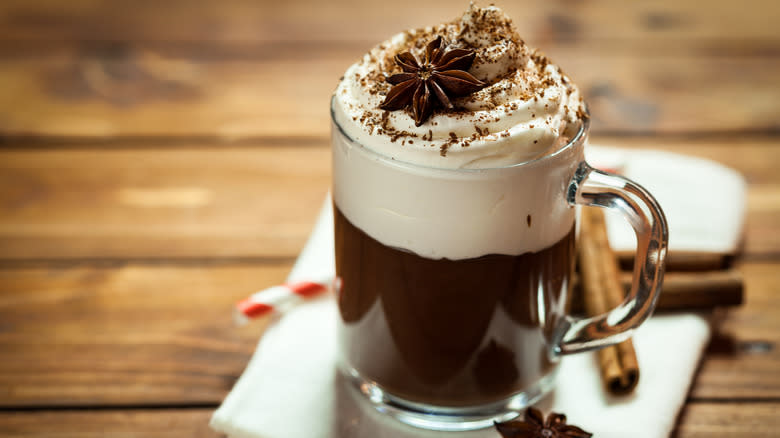The Ingredient That Will Take Your Hot Chocolate From Basic To Gourmet

The hot chocolate scale begins with powdered mixes and tiny dehydrated marshmallows. It's nostalgic, it's easy, and it's pretty tasty. But if you're going to make a really decadent mug of hot chocolate, you'll need to move beyond the packet. Depending on how thick you like your hot chocolate, you'll need to use either melted chocolate or cocoa powder — and you can't skimp on either. And if you're going to make a gourmet version, you need to graduate beyond the can of whipped cream.
You could make whipped cream from scratch, but truly decadent, gourmet hot chocolate calls for something more. It calls for cheese. Don't go running for the hills -- no one is suggesting you float a chunk of Roquefort on your hot chocolate. Instead, turn to the hero of tiramisu: mascarpone.
Mascarpone has a high fat content, like an amped-up whipped cream (and can even be a substitute for heavy cream in a pinch). And because it's more stable than whipped cream, it will melt into your drink more slowly, giving you longer to enjoy your thick, decadent hot chocolate. You could just dollop sweetened mascarpone atop your cup, or you could combine it with heavy cream, sweeten it with sugar, honey, or maple syrup, and whip it into the most luxurious hot chocolate you've ever enjoyed.
Read more: 8 Chocolate Bars That Are Totally Different Outside The US
Making The Most Gourmet Hot Chocolate

For the best hot chocolate of your life — the kind that's a dessert in itself — there are a few tricks. The first is to get the deepest, richest chocolate flavor ever. To accomplish this, you need both high-quality chocolate and Dutch-processed cocoa powder. As Alton Brown claims, cocoa powder can actually taste more chocolatey than chocolate. By combining cocoa powder with just enough hot water to form a paste and letting it sit for a few minutes (a technique called blooming), the flavor deepens. Finely chop the chocolate so it melts easily and provides a richer density to the final product. Depending on your preference, you can choose dark, bittersweet, semi-sweet, or milk chocolate. Use whole milk because its higher fat content will add to the thick, creamy mouthfeel. For dairy-free, use coconut milk and coconut cream.
To further enhance the chocolatey flavor, add a pinch of salt, a bit of vanilla extract, and a touch of dark, strong coffee. For a Mexican-inspired hot chocolate, add a bit of cinnamon and cayenne to the cocoa powder during the blooming process.
Regardless of which direction you take your treat, top it with whipped mascarpone. Depending on how sweet the hot chocolate is, use the mascarpone to balance it. If the drink is more bitter, make the mascarpone sweeter; if it's already reasonably sweet, dial back the sugar in the mascarpone topping. As the mascarpone topping melts, it will impart flavor to your warm beverage.
More About Mascarpone Cheese

Mascarpone isn't too unlike cream cheese or ricotta: It's a soft, acid-set (versus rennet-set), rindless cheese. However, ricotta — which is made from only milk — has a milk fat content of about 10%. Cream cheese — made with a combination of whole milk and cream — has a fat content of 33% to 45%. By contrast, mascarpone is made solely from cream and has a very high milk fat content of 60% to 75%. This gives it a texture somewhere between thick clotted cream or crème fra?che and whipped cream cheese. It's rich, creamy, decadent, and luxurious. And it whips up very well, lending structure to whipping cream.
Once you have a tub of mascarpone for gourmet hot chocolate, it might not last long -- but there are plenty of ways to use it up if there's some left over. You can use it as a snack dip for berries or fancy crackers to keep things simple. Turn it into decadent desserts like cranberry mascarpone cheesecake or lemon panna cotta. You can even use it in savory dishes: It gives a creaminess to a bougie breakfast sandwich with avocado and pomegranate and magic to twice-baked potatoes. And, of course, no one will tell if you eat it with a spoon right out of the container.
Read the original article on Daily Meal.